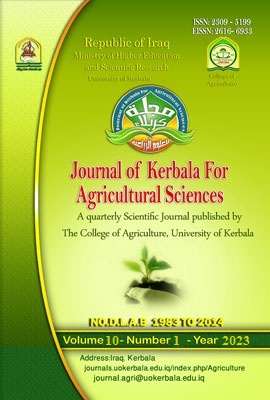Abstract
An experiment was carried out at Seed Technology Laboratory, College of Agriculture, University of Baghdad in the year of 2017 to investigate the response of seed
germination of four synthetic cultivars of maize (Fajr1, Almaha, Baghdad3 and Sara)
under four levels of salt stress by using sodium chloride (0, 1, 4 and 7 dS.m-1
). The
complete randomized design was used with four replicates. The results showed that
the cultivar and the electrical conductivity and their interaction had a significant effect on most studied traits. The highest ratio of variability in the studied traits was related to the effect of electrical conductivity compared to cultivar effect. The cultivar
of Baghdad3 was supremacy on other cultivars when gave the highest averages of
germination ratio, lengths of plumule and radicle, seedling dry weight and seedling
vigour index. There was a significant negative linear relationship between electrical
conductivity and the traits that mentioned above. The control treatment gave the
highest averages for those traits, which decreased when electrical conductivity was
increased and a significant difference was found between all levels. The cultivar of
Baghdad3 had supremacy on other cultivars at each level of electrical conductivity in
most traits. It can be concluded that the cultivar of Baghdad3 was the best studied
cultivars that tolerate salinity during stages of germination and seedling growth. It
can be recommended that to use it in saline lands or when irrigated with saline water
germination of four synthetic cultivars of maize (Fajr1, Almaha, Baghdad3 and Sara)
under four levels of salt stress by using sodium chloride (0, 1, 4 and 7 dS.m-1
). The
complete randomized design was used with four replicates. The results showed that
the cultivar and the electrical conductivity and their interaction had a significant effect on most studied traits. The highest ratio of variability in the studied traits was related to the effect of electrical conductivity compared to cultivar effect. The cultivar
of Baghdad3 was supremacy on other cultivars when gave the highest averages of
germination ratio, lengths of plumule and radicle, seedling dry weight and seedling
vigour index. There was a significant negative linear relationship between electrical
conductivity and the traits that mentioned above. The control treatment gave the
highest averages for those traits, which decreased when electrical conductivity was
increased and a significant difference was found between all levels. The cultivar of
Baghdad3 had supremacy on other cultivars at each level of electrical conductivity in
most traits. It can be concluded that the cultivar of Baghdad3 was the best studied
cultivars that tolerate salinity during stages of germination and seedling growth. It
can be recommended that to use it in saline lands or when irrigated with saline water
